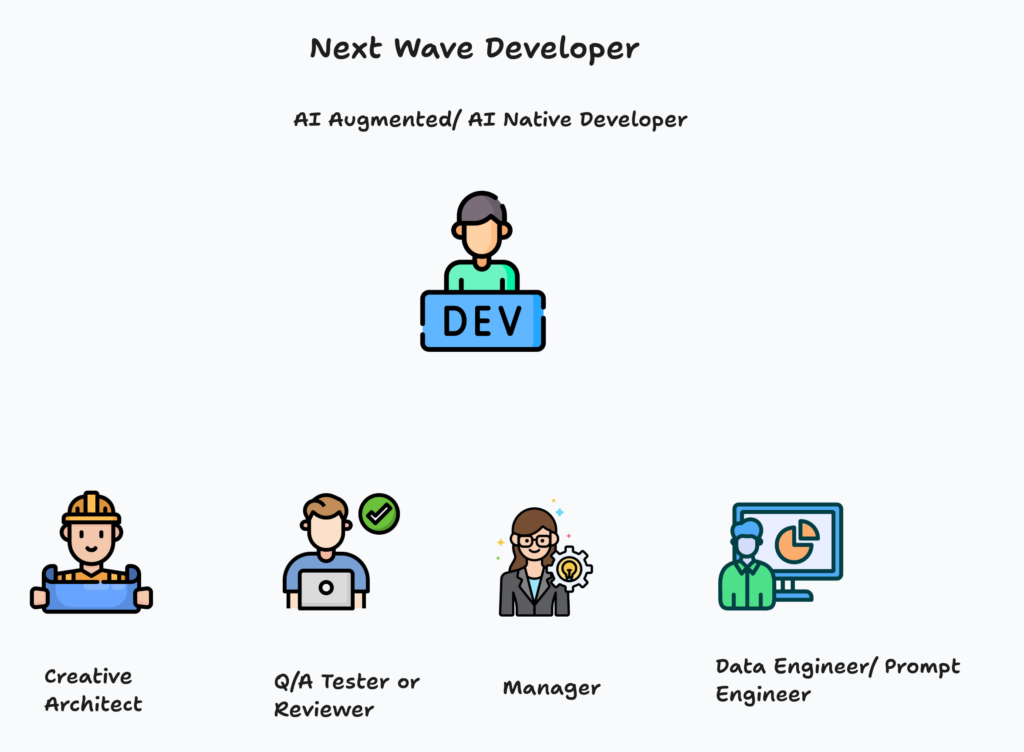Software development is undergoing a profound transformation. The rise of artificial intelligence (AI) and LLM specifically is reshaping how applications are designed, built, and maintained. As businesses look to harness the power of Generative AI for competitive advantage, three distinct types of software development roles are emerging: the traditional developer, the AI-augmented developer, and the AI-native developer.
In the first wave of software development, we had the traditional software developer or engineer who works with tools to provide a solution via coding. In the new wave of software developers, developers do not just work with tools they use tools that have a form of AI agency, which makes the tools act as co-developers alongside the main developer. They are not just coders but also conductors of agentic tools.
Understanding the differences between these roles is essential for organizations and professionals aiming to thrive in the new era of intelligent systems.

1. Traditional Software Developer
Traditional software development is built on deterministic logic, where every feature, rule, and exception is explicitly programmed by the developer. The development cycle tends to be linear: requirements gathering, design, coding, testing, and deployment. Any changes—whether adding new features or correcting errors—must be implemented manually. There is more typing by the developer. More coding but at a slow pace.
Characteristics:
- Relies on fixed, rule-based logic.
- Software behavior is predictable but rigid.
- Updates and improvements require manual coding.
- Skillset is focused on programming languages, algorithms, and system design.
- Typical use case: A customer support chatbot with hard-coded responses that never changes unless edited directly by a developer.
2. AI-Augmented Developer
AI-augmented development introduces AI and machine learning (ML) into traditional software systems as enhancements or add-ons. Here, developers still build the core application, but they integrate AI components to deliver advanced features—such as natural language processing, recommendation engines, or fraud detection. This approach requires teams to be proficient in both general programming and AI/ML methodologies.
Characteristics:
- AI augments, but does not drive, core application logic.
- System can adapt or learn in certain areas (e.g., personalized recommendations).
- Development remains largely within the traditional SDLC, with additional steps for model training and integration.
- Skillset includes basic data science and AI/ML frameworks, often collaborating with data scientists.
- Typical use case: Adding an AI-driven product recommendation engine to an e-commerce platform, while the rest of the system remains traditionally coded.
3. AI-Native Developer
AI-native development represents a fundamental paradigm shift. In this model, AI is not just an added feature—it’s the organizing principle of the entire system. AI-native software is designed from the start to be adaptive, data-driven, and context-aware. AI-Native places intelligence at the core, with every aspect of the system designed around AI capabilities. The developer transitions from writing explicit instructions to specifying high-level goals, orchestrating workflows, and overseeing AI agents that generate, test, and refine code and logic automatically. In this type, he act as an architect, a manager, a reviewer and more.
Characteristics:
- AI is central to system architecture, not a plugin or module.
- The system learns and evolves continuously, adapting in real-time to new data and environments.
- Developers focus on intent, high-level specifications, and oversight, rather than low-level coding.
- Skillset involves working with AI orchestration tools, guiding AI agents, and ensuring human-aligned outcomes.
- Typical use case: Building a payment processing system where fraud detection and prevention are handled end-to-end by AI models that automatically learn from transaction data and adjust decision logic on the fly.

Comparison Table
| Role | Approach | Core Skills | Adaptability | Example Scenario |
|---|---|---|---|---|
| Traditional Developer | Explicit programming | Algorithms, code architecture | Rigid | Hard-coded chatbot |
| AI-Augmented Developer | AI-enhanced components | Programming + AI/ML model integration | Adaptive in parts | AI-driven recommendation engine |
| AI-Native Developer | AI at the core | Intent specification, AI orchestration | Fully adaptive | Self-evolving fraud detection system |
The New Phase: AI-Native Software Development
AI-native development is widely considered the next phase of software engineering. Here, developers and AI systems collaborate more closely—developers describe “what” the software should achieve, and AI designs and implements “how” to achieve it. This approach results in systems that:
- Are deeply integrated with data and learning mechanisms.
- Can adapt automatically as environments or requirements change.
- Enable faster innovation and resilience in the face of complexity and uncertainty.
For organizations, embracing AI-native development means rethinking both technical architectures and team structures. Developers must shift from being coders to being conductors, guiding intelligent systems rather than micromanaging logic.
Conclusion
The journey from traditional to AI-native development mirrors the broader evolution of technology itself—from static, rule-bound systems to ones that are intelligent, adaptive, and self-improving. Understanding this progression is vital for anyone involved in software engineering or digital transformation. Those who master the skills and mindset of the AI-native developer will play a central role in shaping the future of technology.
You can check out the video discussion about this here
Thanks for your attention
Jesus Saves
By Jesse E.Agbe(JCharis)